Resource and Development Class X
Topics to cover:
1.Resources.
2. Interdependent relationship between Nature, Technology and Institution.
3. Classification of Resources.
4. Resources Development with Sustainable Development.
5. Rio de Janeiro Earth Summit, 1992 and Agenda 21.
6. Resource Planning in India- Stages
7. Conservation of Resources.
8. Land as A Resource : Land Utilization ,Land use pattern in India, Land Degradation, Conservation Measures.
9. Soil as a Resource: Classification of Soil , Soil Erosion and Soil Conservation.
10. Land Reclamation
Interdependent relationship between Nature, Technology and Institution.
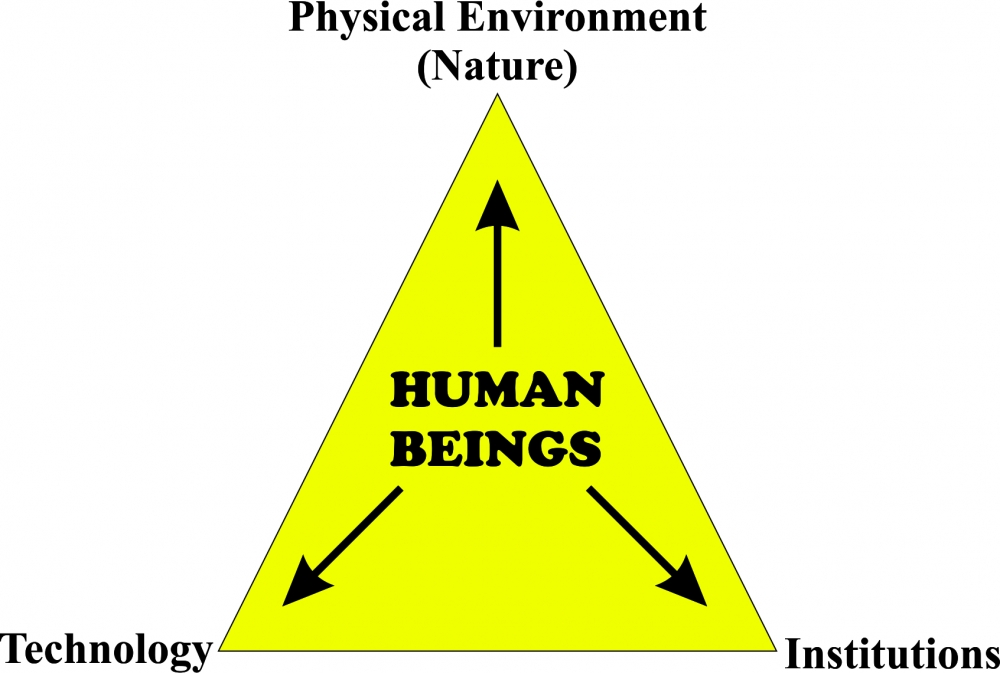
Resource: Everything available in our environment which can be used to satisfy our needs, provided, it is technologically accessible, economically feasible and culturally acceptable can be termed as "Resource".
Classification of Resources:

1. On the basis of Origin of Resources:
(a) Biotic
(b) Abiotic
(a) Biotic Resource: All living things are known as Biotic Resources. These resources are obtained from the Biosphere and they have life, such as – Human Beings, Flora, Fauna, fisheries, etc.
(b) Abiotic Resource: All non-living things are known as Abiotic Resources, such as Wind, Water, Air, Rocks, Metals, etc.
2. On the basis of Exhaustibility of Resources: Exhaust+Ability
means on the basis of their ability to get exhaust they are divided in to
(a) Renewable :
(b) Non-Renewable
(a) Renewable Resource: Re (means Again)+ New+able = if the resource is able to be new again or not.
Resources which can be renewed or reproduced by physical, chemical or mechanical process are known as Renewable or Replenishable Resource. E.g. Solar & Wind energy, Water, etc.
Renewable resources are further classified into continuous or flow.
Many resources are replenishable which means these resources are recycled within the environment by natural process and their quantities remain constant. E.g. Oxygen Cycle and Water Cycle take place rapidly, whereas e.g. like Rock Cycle is very slow.
(b) Non-Renewable Resource: No+Re+New+Able = Not being able to renewe again.
Fossil Fuels like, coal, petroleum, natural gas are the best examples of non-renewable resource. These resources are limited in supply and it takes millions of years in their formation.
Metals like Gold, Silver, Copper and Iron are recyclable.
3. On the basis of Ownership of Resources:
(a) Individual
(b) Community
(c) National
(d) International
(a) Individual Resource: Resources which are owned by an individual. E.g. plot, car, house, etc.
(b) Community Resource: Resources which belongs to a community of people. E.g. parks, community halls, picnic spots, etc.
(c) National Resource: Resources which belongs to a nation. These resources are found within the political boundaries and territorial waters (i.e ocean water upto 12 nautical miles (22.2 kms) from the coast of a country. E.g. rivers, forests, minerals, etc.
The country has legal powers to acquire private property to facilitate public.
(d) International Resource: Resources which are found beyond the territorial boundaries of a country. These resources are managed by the international institutes. No single country can use these resources without the permission of the international authorities. E.g. Minerals, fisheries, etc.
4. On the basis of Distribution of Resources:
(a) Ubiquitous
(b) Localised
(a) Ubiquitous Resource: Resources which are found everywhere are called ubiquitous resource. E.g. air, land, water, etc.
(b) Localised Resource: Resources which are found only in certain places are localised resources, like coal, petrol, iron, etc.
5. On the basis of Stage of Development of Resources:
(a) Actual or Developed Resource
(b) Potential Resource
(c) Reserves
(d) Stock
(a) Actual or Developed Resource: Resources whose existence has been proved and whose quality, quantity and location has been determined for utilization with the available technology.
(b) Potential Resource: Resources which are found in a region but have not been utilized, might be because of the lack of technology. They can be used in future. E.g. Solar and Wind are potential resource. Rajasthan and Gujarat have great potential for the development of these two resources.
(c) Reserves: Resources which can be put into use with the help of the existing technology but their use has not been started. They can be used in future. E.g. more rivers can be used for generating electricity.
(d) Stocks: Reserves which have the potential to satisfy the human needs but we don't have the technology to access it.
Development of Resources:
Resources are the free gifts of nature and are very important for human beings. Some of the problems faced are:
• Depletion of resources for satisfying the greed of few individuals.
• Accumulation of resources in only few hands leaves others unsatisfied.
• Unsystematic use of resources is creating many problems around the world, such as global warming, ecological crisis, disturbance in ozone layer, etc.
Sustainable Development:
Sustain+Able+Development= A development which makes you able to be able to sustain for a long period of time.As it looks after
fulfillment of the needs and demands of present generation,
by not compromising the needs and demands of future generation,
and
also not by hampering, devastating the enviornment.
So, we can define it as,
Development which should takes place without damaging the environment and compromising with the needs of the future generations is called sustainable development.
Rio de Janeiro Earth Summit, 1992:
• In June 1992, more than 100 heads of states met in Rio de Janeiro in Brazil, for the first International Earth Summit.
• The Summit was organized for addressing urgent problems of environmental protection and socio-economic development.
• The assembled leaders signed the Declaration on Global Climatic Change and Biological Diversity.
• The Rio Convention endorsed the global Forest Principles and adopted Agenda 21 for achieving Sustainable Development in the 21st century.
Agenda 21:
•The best part of this agenda 21 is that it is highly flexible that at each level the government can modify it as per their convenience.
• It aims at achieving global sustainable development.
• It is an agenda to combat environmental damage, poverty, disease through global co-operation on common interests, mutual needs and shared responsibilities.
• One major objective of the Agenda 21 is that every local government should draw its own local Agenda 21.
Resource Planning:
•If you are going for resource development then ultimately it will lead to resource planning as the next step, As only a proper planning can lead to proper development.
• Resource planning is the judicious use of resources.
• In India, resources are unevenly distributed and thus resource planning becomes very essential.
• In India, many states are rich in mineral and deficient in other resources, such as Jharkhand is rich in minerals, but there is problem of drinking water and other facilities, Arunachal Pradesh has plenty of water but lack of other development because of lack of resources.
• These types of discriminations can be reduced or completely eradicated with proper planning of judicious use of resources.
Resource Planning in India:
• In order to get the maximum output, a good resources planning is must keeping in mind the technology, skills and institutions.
• Since independence "Five Year Plans" have played a vital role in planning and development of the resources.
Following are the main points of Resource planning.
(a) Identification of resources across the country.
(b) Proper planning structure with appropriate technology, skill and institutions.
(c) Matching the resource development plans with overall development plans.
Conservation of Resources:
• availability of resources is not the only requirement to bring development of any region, along with it technological development, past of the region, human skills are also very very required. like India was called as the golden bird in the ancient time , and that is the reason for which the Europeans came to India and plundered our wealth foe nearly 200 years. that is the reason for which our growth paused for a long time and we could not develop although we had resources.
• Irrational consumption and over-utilization of resources have lead to socio-economic and environmental problems.
• Judicious use and conservation of resources is must. Gandhiji told "There is enough for everybody's need and not for any body's greed." He thought that exploitative nature of modern technology is the root cause for depletion at global level. He believed in the production by masses and not in the mass production.
Land Resources:
• Land is one of the most important natural resources.
• Land supports our life system with the basic necessities of life (i.e. food, cloth and shelter). Thus, proper planning is must for the proper utilization of land as a resource.
• Land is not even everywhere, India comprises of many types of land forms (i.e mountains, plateau, plains and islands).
Plain: About 43% of land area in India is in the form of plains. Plains provide facilities for agriculture, building of industries and houses, etc.
Mountains: About 30% of land area in India is in the form of mountain. Mountain supports the perennial flow of rivers, which carry fertile soils, facilitate irrigation and provide drinking water.
Plateau: About 27% of land in India is in the form of plateau which provides many types of minerals, fossil fuels and forest.
Land Utilization:
Land Resources are used for following purposes:
1. Forests
2. Land not available for cultivation:
(a) Barren and waste land.
(b) Lands used for buildings, roads, factories, etc. (i.e. for non-agriculture purpose).
3. Other Uncultivated Land (excluding fallow land):
(a) Permanent pastures and grazing land.
(b) Land under miscellaneous tree crops groves (not included in net sown area).
(c) Cultruable waste land (left uncultivated for more than 5 agricultural years).
4. Fallow Lands:
(a) Current fallow-(left without cultivation for one or less than one agricultural year).
(b) Other than current fallow-(left uncultivated for the past 1 to 5 agricultural years).
5. Net Sown Area: Area which is sown at least once in a year is called net sown area.
6. Gross Cropped Area: Area sown more than once in an agricultural year plus net sown area is known as gross cropped area.
Land Use Pattern in India:
• Pattern of use of land depends upon physical and human factors both.
• Climate, topography, type of soil, etc. are considered as physical factors.
• While population, technology, skill, population density, tradition, capability, etc. are considered as human factors.
• India has total 3.28 million square kilometre land used data. But only 93% of land of total geographical area is available. This is because land used data has not been collected for the north eastern states except Assam and the land occupied by Pakistan and China has not been surveyed because of many unavoidable reasons.
• The land under permanent pasture is decreasing; this will create the problem for grazing.
• The total net sown area (NSA) is not more than 54% including land other than fallow land.
• Land other than fallow land is either of poor quality or too costly to cultivate, these lands are cultivated only once or twice in two or three consecutive years.
• The pattern of net sown area varies widely from state to state. Where net sown area is 80% in state like Punjab, it is only 10% in the state of Arunachal Pradesh, Mizoram, Manipur and Andaman and Nicobar Island. Such difference is creating lot of discrimination.
• According to National Forest Policy (1952), the forest should be 33% of total geographical area, which is essential to maintain ecological balance. But the forest area in India is far less than desired measures. This is because of illegal deforestation and development which cannot be overlooked, such as construction of roads and building, etc.
• On the other hand, a large population which is dwelling at the edge of forest depends upon the forest and its produce, resulting in the reduction of forest area.
• Moreover, continuous use of land over a long period without taking measures to conserve and manage, degrade them. This has led to serious problem to environment.
Land Degradation & Conservation
• Land is limited but the demand is increasing everyday.
• The change in land use pattern shows the changes in the society.
• Land Degradation: It is the decline in the productive capacity of land for some time or permanently.
• Most of our basic needs (i.e. food, clothing & shelter) is obtained from land.
• But in past few decades the quality of land is degrading fiercely because of human activity.
• Presently, about 130 million hectare of land is reported under degraded land in India.
• Approximately, 28% of land belongs to forest degraded area.
• 56% is water eroded land area.
• Rest degraded land is because of over deposition of salinity and alkalinity.
• Overgrazing, mining, deforestation, division of lands in small area because of family disputes, etc. are some of the major causes of degradation of land.
• In the states of Jharkhand, Chhattisgarh, Orissa and Madhya Pradesh along with mining, deforestation in these states has degraded the land very fast.
• In the states of Gujarat, Rajasthan, Madhya Pradesh, Maharashtra overgrazing is the major cause of land degradation.
• In the states of Uttar Pradesh, Punjab, Haryana, over irrigation causes water shortage and increase in salinity and alkalinity due to water logging.
• In Bihar, Assam, Arunachal Pradesh, land is degraded because of flood.
• The degradation of land creates many problems, such as flood, decrease in yield, etc. which leads to decrease in GDP and country has to face economic problems.
Land Degradation & Conservation
Common causes of land degradation are:
1. Deforestation
2. Overgrazing
3. Urbanization
4. Industrialization
5. Dumping of Chemical Wastes
6. Excessive use of Fertilizers
7. Bad Farming Techniques
Some of the measures to control land degradation are:
1. Constructing retention walls in the mountain areas to stop landslides.
2. Land Reclamation (i.e. Proper management of waste lands)
3. Regulated use of chemical fertilizers and pesticides
4. Afforestation
5. Check on Overgrazing
6. Control of Mining Activities
7. By proper irrigation.
8. By proper harvesting.
9. Discharge of industrial waste and effluents only after proper treatment.
10. By preventing the deforestation.
SOIL
• The uppermost or topmost layer of the earth's crust is known as soil. It is the loose material consisting of organic and inorganic substances.
(Humus is a dark coloured stable form of organic matter that remains after most of plant or animals residues have decomposed).
• Most of the food items like wheat, rice, pulses, fruits, vegetables, etc. are obtained from plants that grow on soil. Soil provides food, cloth and shelter, etc.
Factors of Soil Formation:
1. Relief: Altitude and slope determines the accumulation of soil.
2. Parent Rock: It determines, colour, texture, chemical properties, mineral contents, etc.
3. Climate: Rainfall and temperature influence rate of humus and weathering.
4. Time: It determines thickness of soil profile.
5. Organisms: Microorganisms & vegetation affect the rate of humus formation.
Soil Profile:
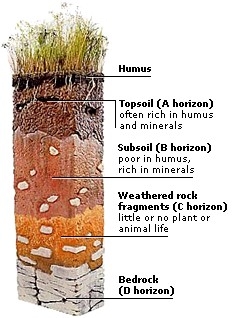
Soil profile refers to the different layers of the soil. There are four different layers:
1. Top soil
2. Sub Soil
3. Weathered Rock
4. Bed Rock or Parent Rock
1. Top Soil:
• It is the uppermost layer.
• Rich in humus and minerals.
• Consists of Sand, Silt & Clay.
2. Sub Soil:
• It lies below the top soil and supports moisture.
• Consists of weathered rock, Silt & Clay and some nutrients.
3. Weathered Rock
4. Bed Rock:
• Consists of solid layer of unweathered Rock.
Classification of Soil:
Soils are classified on the basis of colour, texture, fertility, mineral content, etc. Broadly, soil is classified into six types: -
1. Alluvial Soil
2. Black Soil
3. Red & Yellow Soil
4. Forest Soil
5. Laterite Soil
6. Arid Soil
Follow the given link for details study of Soil Types of India.
Alluvial Soils
- The entire northern plains are made of alluvial soil.
- The Alluvial Soil is deposited by 3 important Himalayan river systems – the Indus, the Ganga and the Brahmaputra.
- It is also found in Rajasthan, Gujarat and eastern coastal plains particularly in the deltas of the Mahanadi, the Godavari, the Krishna and the Kaveri rivers.
- The alluvial soil consists of various proportions of sand, silt and clay. As we move inlands towards the river valleys, soil particles appear to be bigger in size whereas in the upper side of the river valley, the soils are coarse.
- Based on age, Alluvial soils can be classified as:
- Old Alluvial (Bangar): The Bangar soil has a higher concentration of kanker nodules than the Khadar.
- New Alluvial (Khadar): It has more fine particles and is more fertile than the Bangar.
- Alluvial soils are very fertile. These soils contain an adequate proportion of potash, phosphoric acid and lime, which are ideal for the growth of sugarcane, paddy, wheat and other cereal and pulse crops.
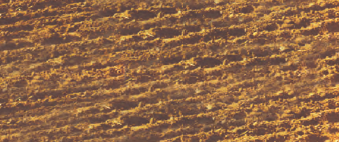
Black Soil
- This soil is black in colour and is also known as regur soil. Climatic conditions along with the parent rock material are the important factors for the formation of black soil.
- The soil is ideal for growing cotton and is also known as black cotton soil.
- This type of soil is typical of the Deccan trap (Basalt) region spread over northwest Deccan plateau and is made up of lava flows.
- The soil covers the plateaus of Maharashtra, Saurashtra, Malwa, Madhya Pradesh and Chhattisgarh and extends in the south-east direction along the Godavari and the Krishna valleys.
- The black soils are made up of extremely fine i.e. clayey material and well-known for their capacity to hold moisture.
- Black soil is nutrients rich and contains calcium carbonate, magnesium, potash and lime.
- The soil is sticky when wet and difficult to work on unless tilled immediately after the first shower or during the pre-monsoon period.
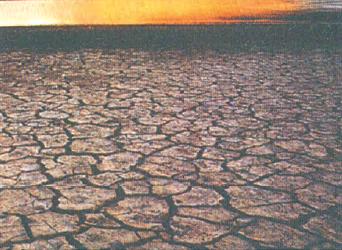
The next two types of soil are not very fertile but not infertile too.
Red and Yellow Soils
- This type of soil develops on crystalline igneous rocks in areas of low rainfall in the eastern and southern parts of the Deccan plateau.
- These soils develop a reddish colour due to diffusion of iron in crystalline and metamorphic rocks. It looks yellow when it occurs in a hydrated form.
- Found in parts of Odisha, Chhattisgarh, southern parts of the middle Ganga plain and along the piedmont zone of the Western Ghats.
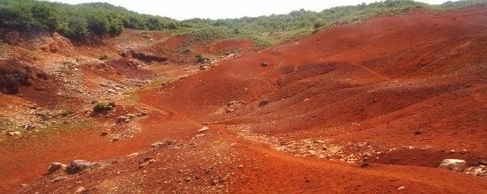
Forest Soils
- These soils are found in the hilly and mountainous areas.
- The soil texture is loamy and silty in valley sides and coarse grained in the upper slopes.
- In the snow covered areas of Himalayas, these soils experience denudation and are acidic with low humus content. The soil is fertile on the river terraces and alluvial fans.
Now the two soils which are not fertile or the infertile soil:
Laterite Soil
- The laterite soil develops under tropical and subtropical climate with the alternate wet and dry season.
- This soil is the result of intense leaching due to heavy rain.
- Lateritic soils are acidic (pH<6.0) in nature and generally deficient in plant nutrients. This type of soil is found mostly in Southern states, Western Ghats region of Maharashtra, Odisha, some parts of West Bengal and North-east regions.
- The soil supports deciduous and evergreen forests but humus poor.
- This soil is very useful for growing tea and coffee.
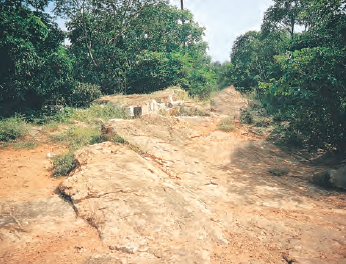
Arid Soils
- Arid soils range from red to brown in colour.
- This soil is generally sandy in texture and saline in nature. In some areas, the salt content is very high and common salt is obtained by evaporating the water.
- Arid soil lacks humus and moisture.
- The lower horizons of the soil are occupied by Kankar because of the increasing calcium content downwards. The Kankar layer formations in the bottom horizons restrict the infiltration of water.

The map below shows the different types of soils found in India.
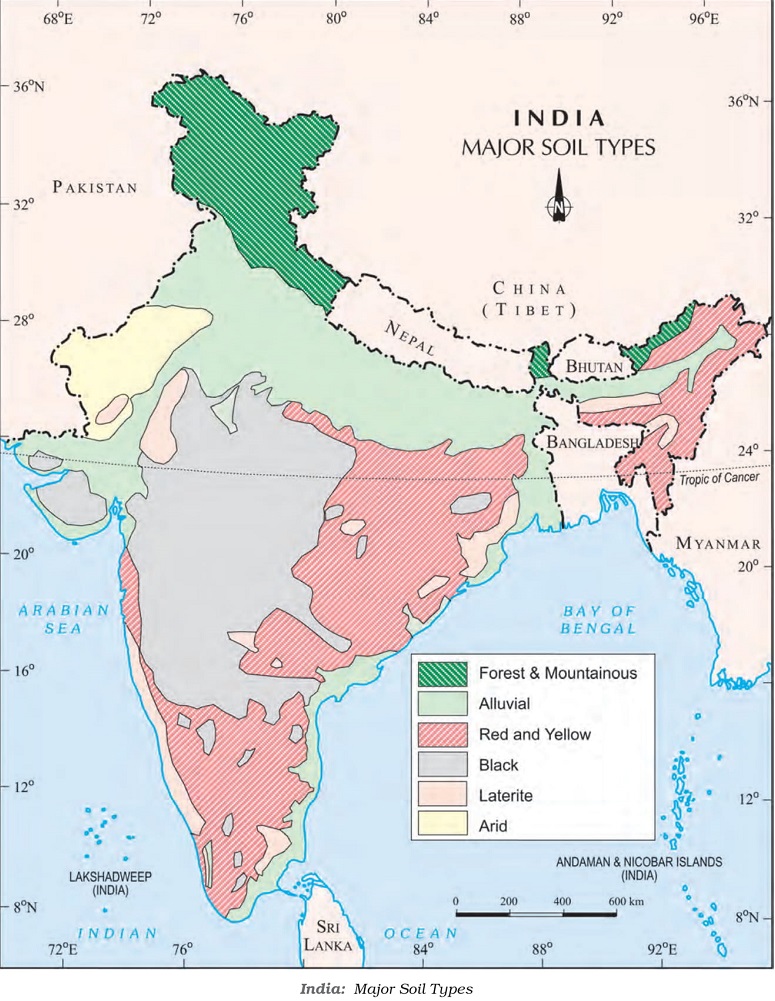
Soil Erosion and Soil Conservation
The running water cuts through the clayey soils and makes deep channels as gullies. The land becomes unfit for cultivation and is known as bad land. When water flows as a sheet over large areas down a slope and the topsoil is washed away, it is known as sheet erosion. Wind blows loose soil off flat or sloping land known as wind erosion.
SOIL EROSION AND SOIL CONSERVATION
• The denudation of the soil cover and subsequent washing down is described as soil erosion. The soil erosion is caused due to human activities like deforestation, over-grazing, construction and mining etc.
Or
• Removal of top soil is called soil erosion.
• Also, there are some natural forces like wind, glacier and water which lead to soil erosion. Soil erosion is also caused due to defective methods of farming.
• The running water cuts through the clayey soil and makes deep channels known as Gullies.
• The land becomes unfit for cultivation and is known as Bad Land. For example we can take instances of Chambal valley.
DEGRADATION OF SOIL
• Soil erosion is the degradation of soil by human activities.
• Following are the factors responsible for the soil erosion: -
1. Deforestation
2. Overgrazing
3. Construction
4. Overuse of Chemical Fertilizers
5. Pesticides
6. Natural Calamities (Flood, landslides, etc.)
CONSERVATION OF SOIL
• Soil conservation means protection, preservation and proper utilization of the soil.
• Some methods of soil conservation are: -
1. Mulching: Bare ground between plants is covered with a layer of organic matter like straw. It helps to retail soil moisture.
2. Contour Ploughing: Ploughing along contours can decrease the flow of water down the slopes.
3. Terrace Cultivation: Steps can be cut out on the slopes making terraces.
4. Strip Cropping: Strips of grass are grown between the crops. This breaks the force of wind.
5. Shelter Belts: Rows of trees are planted to create shelter. Thus, the speed of wind is reduced.
6. Rock Dam: Rocks are piled to slow the speed of wind.
7. Contour Barriers: Stones, grass, soil are used to make barriers. Trenches are made in front of the barriers to collect water.
8. Afforestation, Crop Rotation, Control over Deforestation and Overgrazing, etc.
Land reclamation: usually known as reclamation, and also known as land fill (not to be confused with a waste landfill), is the process of creating new land from oceans, seas, riverbeds or lake beds. The land reclaimed is known as reclamation ground or land fill.
Subscribe my Youtube Channel for more videos

Thank you mam for your efforts to make our marks better.
ReplyDelete